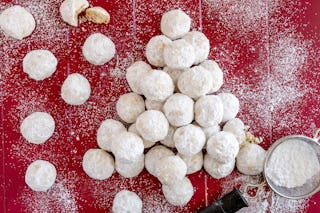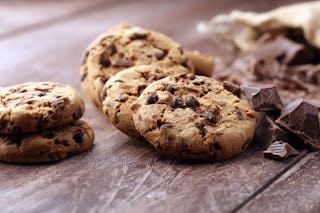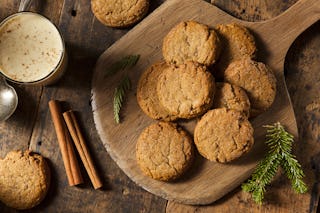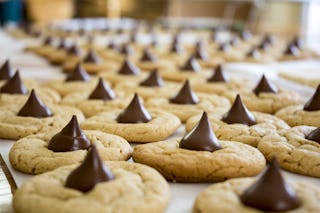
There always seem to be cookies around during the holidays! Decorating gingerbread men, icing sugar cookies, and grabbing cookies by the handful from cookie tins set out on the table are Christmas traditions many of us have.
But where do all of those familiar cookies come from? Check out the origins of some of the most popular Christmas cookies below.
Gingerbread Men
A holiday classic, gingerbread can be traced back to the ancient Greeks and Egyptians, who used it for ceremonial reasons. Queen Elizabeth I created the very first gingerbread man, presenting visiting royalty with a gingerbread cookie shaped and decorated in each person’s likeness. Of course, the practice took off and we make them in all kinds of shapes every year!

Shortbread Cookies
Shortbread cookies come in all flavors – cinnamon, lavender, brown sugar, chocolate hazelnut – and are often gifted in assorted tins around the holidays. But shortbread actually originated in Scotland around the 12th century, used for special occasions like weddings and holidays. They’re made with common ingredients – flour, sugar, and butter – and are considered a Christmas staple.

Pizzelles
Pizzelles are cookies made waffle-style – the batter is poured between two iron plates and cooked through. They originated in Italy during the 8th century, but two areas lay claim to their invention – Salle and Coculo. The cookies are closely associated with family (many families include them in their crests) and are almost always eaten at Italian weddings. And, of course, we love to eat them for the holidays!

Chocolate Crinkle Cookies
Soft, rich, fudgy, and topped with powdered sugar that crinkles – how can you not love these cookies? They began in the early 20th century in St. Paul, Minnesota. Betty Crocker featured a recipe from a woman by the name of Helen Fredell for molasses crinkle cookies – they took off! It’s not clear who made the cookies chocolaty, but it only took a few ingredient swaps to create a cookie staple.

Iced Sugar Cookies
Families around the world gather to decorate Christmas sugar cookies in all shapes. But Christmas cookies actually originated in the Middle Ages, where they used prized, rare goods like sugar and lard to make cookies only around the holidays. The sugar cookie made its debut in the 1700’s in Pennsylvania, where German settlers created the round, crumbly, buttery sweet cookie that we decorate each year. In the 1930’s, children began leaving out cookies for Santa and the trend continued from there!

Snickerdoodle Cookies
These cinnamon sugar cookies have all the warm flavors we associate with Christmas! Nobody’s quite sure exactly where they originated. Dutch and German settlers often made cookies covered with cinnamon sugar and shaped like snails (the German word for snail dumpling is Schnecke Knödel). Other historians believe they originated in New England in the early 19th century.

Oatmeal Cookies
Chewy, sweet oatmeal cookies are often packed with raisins and are a staple around the holidays! They came from the original British oat cakes that were carried by soldiers to boost energy during war time. Fannie Merritt Farmer wrote the first recipe that we’d recognize today in 1896.

Snowball Cookies
Powdery white with chopped nuts, snowball cookies go by many names – Russian tea cakes, Mexican wedding cookies, and butterballs. Their actual history isn’t clear, but the theory is that they came from England where they were served with tea and migrated to Mexico where they were served at weddings. But wherever they came from, they’re certainly a popular Christmas treat!

Thumbprint Cookies
Thumbprint cookies are fun because you get to press your thumb into the dough, forming a well for whatever filling you want to add! They originated in the 19th century, but it’s unclear whether they began in Poland, Sweden, or Eastern Europe. They’re very popular around the holidays, filled with jam, chocolate kisses, or peanut butter.

Chocolate Chip Cookies
The ultimate classic cookie, chocolate chip cookies are found on many Christmas tables. Ruth Wakefield, the owner of the Toll House restaurant in Massachusetts, brought the Toll House chocolate chip cookie into being, later selling the recipe to Nestle. It is thought that Wakefield ran out of nuts for an ice cream cookie recipe and chopped up a bar of dark chocolate instead. The cookies brought a lot of comfort to families during the Great Depression and have been a favorite ever since.

Biscotti (Peppermint)
We love to pair crispy biscotti with coffee and hot chocolate around the holidays! This Italian cookie goes back to Roman times, created as a durable travel food. The dry, unleavened sweet was perfect for the Roman Legions! Later, sailors and fisherman enjoyed their longevity just as much. Eventually, it became so popular that a variety of flavors were developed.

Spritz Cookies
Crisp and buttery, spritz cookies are a traditional Christmas treat from Germany, created by pressing a soft, flaky dough through a cookie press. Of course, this is what creates their unique, fancy designs! Spritz cookies actually go all the way back to the 1500’s and were inspired by gingerbread.

Gingersnaps
In medieval times, ginger was valued for its healing properties and was imported into Europe in crystallized form specifically for baking. Ginger snap cookies were created using molasses instead of sugar simply because it was much cheaper to purchase! And, of course, when the British migrated to the Americas, they brought the tradition of crispy, spicy gingersnaps with them. They quickly became a treat enjoyed around the holidays.

Peanut Butter Cookies
Around the holidays, we often snack on peanut butter cookies on their own or bake them with Hershey’s chocolate kisses pressed on top. While the Aztecs invented peanut butter itself, George Washington Carver made the peanut butter cookie popular. In 1916, he published a variety of ways to use peanuts, including three peanut butter cookie recipes. The rest was history!

Coconut Macaroons
Macaroons (not to be confused with macrons!) were originally made from almond paste, egg whites, and sugar – a delicious blend! They originated in Italy and made their way to France in 1533. Jews began baking the cookie during Passover because it had no flour or leavening and, over time, they added coconut to the original recipe.

Black and White Cookies
With half black icing, half white icing, these cookies look beautiful on any holiday table. They were first seen in the early 20th century at a bakery in New York, a derivative of a fad that was popular during the time. The latest dessert trend involved mixing dark and light elements, like chocolate frosting on a vanilla cake. They’re easy and cheap to make, which made them perfect for bakeries!

Linzer Cookies
A Linzer cookie has all the buttery deliciousness of a tart, but in an easy-to-eat cookie format! Linz is one of the biggest cities in Austria and is home to the Linzertorte, a buttery tart with almonds, lemon zest, and cinnamon, filled with black currant preserves. Linzer cookies use the exact same recipe – two cookies have jam sandwiched in between, with a small cutout exposing the fruit. Americans began replacing the black currant jam with raspberry, the perfect color for Christmas!

Cornflake Cookies
Cornflake cookies are an easy, no-bake treat that are a lot of fun to make with kids around the holidays! Sweet, creamy peanut butter mixed with crunchy cornflakes – what’s not to love? Cornflakes were created when the Kellogs founder accidentally flaked wheat berry in 1898. He kept experimenting until he flaked corn, turning it into the tasty cereal that we know today! While the exact origins of the cookie are unclear, they were most likely made as a time saver, incorporating ingredients already in the pantries of many Americans.